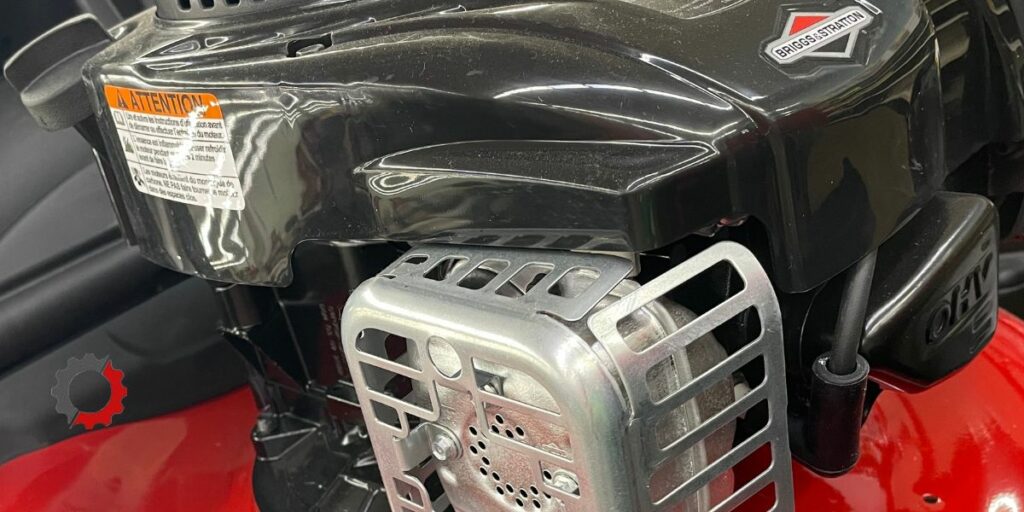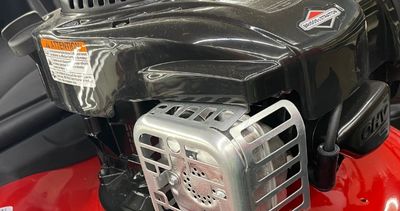You’ve determined you have plenty of fuel in your lawn mower, but for some reason, it just isn’t getting enough gas. It acts very sluggishly almost like it’s going to die.
A Briggs and Stratton engine isn’t getting gas when old or dirty fuel has caused restrictions in the fuel system; the fuel filter is plugged; the fuel line is clogged; the fuel pump is faulty; the carburetor is dirty or the gas cap is bad.
Take caution when working with your fuel system. Make sure you are working in a well-ventilated area. Protect yourself by wearing goggles and gloves and remove the spark plug wire before performing repairs.

This post may include affiliate links. Purchases made through these links may provide a commission for us, at no extra cost to you. As an Amazon Associate, we earn from qualifying purchases.
Follow all safety instructions provided in your equipment operator’s manual prior to diagnosing, repairing, or operating.Consult a professional if you don’t have the skills, or knowledge or are not in the condition to perform the repair safely.
6 Reasons a Briggs and Stratton Engine Isn’t Getting Gas
Old Fuel in Briggs and Stratton Lawn Mower
It’s important to know you should only run fresh fuel through your Briggs and Stratton mower. Gas can begin to break down as quickly as 30 days after purchase so you need to use it within this time.
Old fuel can have negative effects causing the engine to sputter or not start because it isn’t getting gas. Old gas can leave behind varnish and gummy deposits that cause fuel restrictions and component failure.
To help reduce the negative effects of old fuel in the future. Add a fuel additive like Sea Foam or STA-BIL to fresh fuel to keep it stable.
SOLUTION: When you find the fuel is old, drain the fuel tank into an approved fuel container. Fill with fresh fuel that includes a fuel additive like Sea Foam that acts as a fuel cleaner and reduces moisture.
Learn more about the advantages of adding Sea Foam to your fuel here.
Plugged Fuel Filter on a Briggs and Stratton Lawn Mower
The fuel filter is a maintenance component that needs to be replaced at least annually to ensure it is kept clean. When it isn’t changed out regularly, it can become plugged restricting the amount of fuel that is able to pass through the filter.
SOLUTION: Replace a plugged filter with a Briggs and Stratton fuel filter. Pay attention to the arrow located on the side of the plastic housing. The filter must be installed with this arrow pointed in the direction of the fuel flow.
Clogged Fuel Lines on a Briggs and Stratton Lawn Mower
The gummy deposits left behind by old fuel or dirt that entered the fuel system can cause restrictions in the fuel lines. These restrictions can reduce the amount of fuel flow or completely block the fuel line so the Briggs and Stratton doesn’t get fuel.
SOLUTION: Use the fuel shut-off valve or pinch-off pliers to start and stop fuel flow while checking a section of the fuel line to determine whether or not you have a good flow.
Find & remove a restriction in a fuel line:
- Stop the fuel flow using the fuel shut-off valve or pinch-off pliers.
- Remove the end of the fuel line furthest from the fuel tank and place it in a container. Make sure the container is placed lower than the tank so the fuel can run downhill.
- Restart the fuel flow.
- If you are not getting good flow into the container, you must remove the restriction in the fuel line. Do this by stopping the fuel flow and removing the fuel line from your mower.
- Spray carburetor cleaner into the hose and blow the line out with compressed air to remove the blockage. Repeat as necessary until the fuel line is open and no longer restricted.
- Reattach the fuel line onto the mower.
- If you are unable to clear the fuel line so fuel can flow freely, replace your fuel line. It’s also a good time to replace your fuel line before it starts leaking if the line is dry and showing signs of cracking as well.
Bad Fuel Pump on a Briggs and Stratton Lawn Mower
You will have a plastic or metal fuel pump on your lawn mower when the fuel tank sits lower than the carburetor. A vacuum fuel pump is designed to build pressure off of the crankcase. It uses this pressure to push fuel up to the carburetor.
When the fuel pump has cracks, is damaged or leaks, you must replace your fuel pump. If you don’t notice any damage or leaking of the fuel pump, it’s time to troubleshoot the pump to ensure it is working correctly.
SOLUTION: Confirm the fuel pump is functioning properly by, first, checking to make sure you are receiving fuel flow to the pump. You may have already checked this in the previous step when you checked your fuel lines for blockage.
Once you know you are getting a good supply to the inlet port on the fuel pump, remove the fuel line from the carburetor and place it in a container.
Start the mower and watch for a steady or pulsating fuel flow coming out of the line into the container. If you aren’t getting good flow, replace the fuel pump.
Replace a bad fuel pump that is damaged or is not pumping a stream of fuel out of the pump.
Dirty Carburetor on a Briggs and Stratton Lawn Mower
The carburetor regulates the air and fuel mixture allowed into the cylinder to create a combustion. You will find your carburetor mounted to the top or side of the engine block. It is usually below or behind your air filter.
When the carburetor is dirty, the components of your carburetor, including the fuel jet, can become clogged or stuck preventing your Briggs and Stratton engine from receiving fuel.
SOLUTION: Remove your air filter and spray carburetor cleaner into the air intake. Start your engine to see if it will run. If your lawn mower starts and won’t continue to run, you will need to remove your carburetor and take it apart for cleaning.
For instructions on cleaning the lawn mower carburetor, read this article.
Bad Briggs and Stratton Gas Cap
The fuel tank must be able to vent and it does so through the fuel cap. When the fuel cap vent fails and the tank no longer vents, it forms a vacuum. This vacuum will keep fuel from getting to the engine.
SOLUTION: Run the mower with and without the fuel cap to confirm whether or not you have a bad fuel cap problem.
If the engine starts and runs well without the fuel cap loosened or removed, but runs sluggish or dies after you reinstall the fuel cap and allow the engine to run for a while, you may have a problem with your fuel cap.
A bad gas cap should be replaced.
